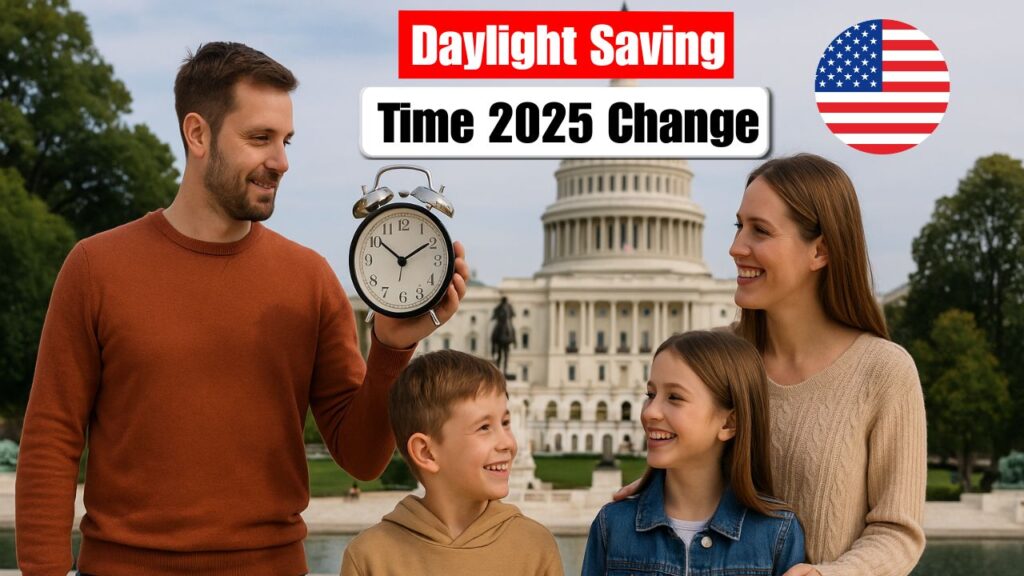Daylight Saving Time 2025 – Daylight Saving Time (DST) 2025 in the United States will once again bring the annual time change that affects millions of Americans. This adjustment helps make better use of natural daylight during the longer summer months by shifting the clock one hour forward in spring and one hour back in fall. The goal is to save energy and extend daylight into the evening hours. Understanding the official start and end dates, as well as which U.S. states follow or skip DST, is crucial for keeping your schedules, meetings, and travel plans accurate throughout the year.

Daylight Saving Time 2025 Schedule for U.S. Citizens
In 2025, Daylight Saving Time in the United States will begin on Sunday, March 9, at 2:00 a.m., when clocks are moved forward by one hour. It will end on Sunday, November 2, at 2:00 a.m., when clocks fall back one hour. This change applies to most states, helping to extend daylight during the warmer months. However, not all regions in the U.S. participate. For example, Hawaii and most of Arizona do not observe DST, keeping their clocks consistent throughout the year. These adjustments can affect everything from flight schedules to work hours, so setting reminders ahead of time is recommended.
 Social Security Boost 2025: These 10 States Getting the Biggest Payment Increases This Year
Social Security Boost 2025: These 10 States Getting the Biggest Payment Increases This Year
Time Change Rules for Americans in 2025
For Americans, the spring forward and fall back routine is familiar but often confusing. During the spring, clocks are set one hour ahead to provide extra evening daylight, reducing the need for artificial lighting. In fall, clocks move one hour back, restoring standard time. While modern devices like smartphones and computers update automatically, manual clocks, ovens, and wall clocks must be changed manually. This shift can briefly disrupt sleep cycles, so experts recommend adjusting your bedtime slightly a few days before the change to minimize its effects on your health and productivity.
 SSA Retirement Age Increase 2025: New Benefit Amounts and Age Rules Every American Should Know
SSA Retirement Age Increase 2025: New Benefit Amounts and Age Rules Every American Should Know
| Event | Date | Time | Action |
|---|---|---|---|
| DST Starts | March 9, 2025 | 2:00 a.m. | Move clocks forward 1 hour |
| DST Ends | November 2, 2025 | 2:00 a.m. | Move clocks back 1 hour |
| States Observing DST | 48 states | — | Follow annual time change |
| States Not Observing DST | Hawaii, Arizona (most areas) | — | No change |
| Federal Authority | U.S. Department of Transportation | — | Regulates DST schedule |
How Daylight Saving Impacts Life Across the United States
Daylight Saving Time impacts almost every aspect of American life — from energy use to daily routines. Longer daylight hours encourage outdoor activities, improve retail sales, and benefit tourism. However, the sudden change can affect sleep patterns and health, especially in children and the elderly. Businesses and schools often prepare ahead to minimize disruption. Some states have debated making DST permanent, citing potential benefits like better mental health and reduced crime rates. Until federal approval, though, Americans will continue adjusting their clocks twice each year as part of the ongoing time policy tradition.
Energy and Lifestyle Benefits for Americans
The main purpose of Daylight Saving Time in the U.S. is to conserve energy by maximizing natural daylight. With evenings staying brighter for longer, households use less electricity for lighting and heating. Additionally, DST promotes physical activity and family time, as Americans have more daylight hours for outdoor recreation after work. Cities like New York, Chicago, and Los Angeles especially benefit from the extended daylight, supporting evening business and leisure. Despite mixed opinions, the concept remains deeply rooted in American culture, symbolizing both efficiency and adaptation to seasonal daylight changes.
Frequently Asked Questions (FAQs)
 $3,000 Child and Dependent Care Credit 2025: Check Updated CTC Amount and Full Eligibility Details
$3,000 Child and Dependent Care Credit 2025: Check Updated CTC Amount and Full Eligibility Details
1. When does Daylight Saving Time start in the U.S. in 2025?
It starts on Sunday, March 9, 2025, at 2:00 a.m. local time.
2. When does Daylight Saving Time end in the United States?
It ends on Sunday, November 2, 2025, when clocks go back one hour.
3. Which U.S. states do not observe Daylight Saving Time?
Hawaii and most parts of Arizona do not follow DST.
4. Why does the U.S. observe Daylight Saving Time?
It helps save energy, promote outdoor activities, and make better use of daylight during summer.

